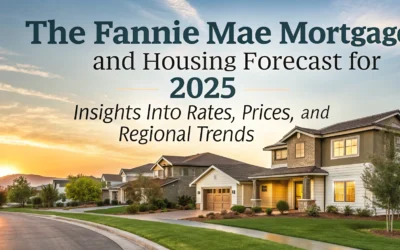The housing market is undergoing a transformative phase as we approach 2025, influenced by a confluence of factors ranging from inventory levels and home prices to mortgage rates and extreme weather impacts. This in-depth analysis aims to unravel these dynamics, offering insightful perspectives for buyers, sellers, and investors, helping them navigate through uncertainties with informed strategies. Our exploration will delve deep into the current and anticipated market trends, expert forecasts, and the real-world impacts observed in various sectors. Stay informed and prepared for the challenges and opportunities that lie ahead in the housing landscape of 2025.
Current Housing Market Dynamics
The current state of the housing market is marked by significant shifts as inventory levels begin to recover, nearly reaching 1 million homes by December 2024. Notably, total housing inventory at the end of December was at 1.15 million units, which represents a 16.2% increase from the previous year, although it still reflects a 13.5% drop from November 2024 [Source: National Association of Realtors]. This recovery impacts market stability, influencing both buyer and seller behavior, as the slight increase in availability has given buyers more options, but the overall supply still favors sellers.
National home price trends are complex, showing a 3.9% year-over-year increase in December 2024, bringing prices significantly above pre-pandemic levels, yet local markets exhibit stark variations [Source: StockTitan]. For instance, while some markets experience sharp price growth due to local demand and limited housing supply, others are seeing declines driven by economic challenges or oversupply. Understanding these local dynamics is essential for both buyers and sellers as they navigate their respective strategies.
The mortgage rate context further complicates the landscape, as rates have consistently surpassed 7%, hovering around an average of 6.72% for a 30-year fixed mortgage in December 2024 [Source: Certified Credit]. Such elevated rates have priced many potential buyers out of the market, locking existing homeowners into their current properties. This stall in the typical fluidity of market transactions adds pressure on inventory levels, even as they begin to recover.
Recent government interventions aim to mitigate these issues, with plans for policies that support homeownership, including potential expansions in down payment assistance and affordable housing initiatives [Source: The Africa Logistics]. While these programs could foster improved affordability, the overarching challenge remains: a sustained period of high mortgage rates, coupled with constrained inventory levels, infers persisting difficulties in achieving homeownership for many potential buyers.
Exploring Housing Inventory and Supply
As we delve further into housing inventory and supply, experts project a modest increase in inventory during 2025, driven by several key factors. This anticipated rise is largely linked to homeowners needing to sell due to personal circumstances such as job changes, divorces, or family expansions, rather than strategic market timing. Despite these expected increases, market conditions remain notably tight, with inventory levels still falling below the 5 to 6 months generally recognized as necessary for a balanced market. Recent data indicates that, as of late 2024, supply had only improved to between 3.8 and 4.2 months, emphasizing the need for further growth in the market to fully meet buyer demand [Source: CBS News].
The role of new construction in augmenting housing inventory cannot be understated. Many builders have expressed a renewed optimism concerning reduced financing costs, contributing to a boost in builder confidence. This uptick in new homes is essential in addressing the ongoing shortages and providing more options for prospective buyers, particularly in regions where demand has historically outstripped supply [Source: ABC News].
While these changes may empower buyers to negotiate more effectively, certain aspects of the market will continue to favor sellers. The overall balance will vary regionally, with places historically marked by high demand still facing tight inventory. For instance, the West and Northeast are expected to remain competitive while other regions, like the Midwest and South, may experience slightly more favorable conditions for buyers due to increasing availability [Source: Bankrate]. Additionally, persistently high mortgage rates are likely to restrict the willingness of current homeowners to sell, as many hold onto lower mortgage rates that they are reluctant to relinquish [Source: Kiplinger].
Current patterns indicate that greater housing inventory could indeed reshape expectations for both buyers and sellers in the coming year. Buyers can foresee more options, albeit within a market framework that still preserves significant advantages for sellers due to the underlying inventory challenges. Such dynamics are crucial for forming real estate strategies and comparative market analyses, especially as we look toward the nuances of 2025.
Forecasting Home Prices and Valuations
The anticipated modest national home price rise of 3-3.5% in 2025 necessitates an examination of several key factors influencing housing values. The National Association of Realtors projects a 2% increase in median home prices, forecasting a median price of approximately $410,700 [Source: True Parity]. In contrast, Fannie Mae’s Home Price Expectations Survey indicates a slightly higher increase of about 3.8%, while Zillow aligns more closely with the conservative predictions at around 2.6% growth [Source: Kiplinger]. Such consensus reveals a marked slowdown compared to the aggressive price surges witnessed over the past few years.
Local variations play a critical role in understanding anticipated home prices. For instance, markets in regions with rising housing inventory, especially in parts of the Midwest and South, may experience stabilization or slight declines in prices due to increased supply [Source: Ashley Lindsey Homes]. Conversely, high-demand areas, particularly in the West and Northeast such as Denver and Miami, are likely to maintain competitive price growth driven by persistent housing shortages [Source: Norada Real Estate].
Economic policies and broader economic trends will also shape home prices going forward. Mortgage rates, which remain a significant determinant of buyer behavior, are expected to fluctuate, potentially impacting purchasing power and sales activity in key markets [Source: Centre Realty Group]. Changes in property tax regulations or government housing incentives will further influence affordability, which is crucial given the varying economic climates across the country.
As the market evolves, a balance may emerge in 2025. Although buying conditions could become more favorable for some, a majority of experts caution that many regions will continue to lean toward a seller's advantage due to persistent inventory constraints [Source: True Parity]. This dynamic places a premium on localized knowledge and adaptive strategies for homebuyers and investors hoping to navigate the changing landscape effectively.
Mortgage Rates and Affordability Challenges
Mortgage rates exceeding 7% pose significant affordability challenges for homebuyers in 2025. The historical context shows that such rates are at their highest in recent years, creating a stark contrast to pre-pandemic levels when rates were closer to 3%. This rise is primarily attributed to shifts in the bond market and heightened inflation expectations, which have led to a reevaluation of mortgage pricing across the market [Source: National Mortgage News].
In response to these ongoing affordability issues, recent executive orders have been introduced to help alleviate financial burdens. For instance, efforts to streamline regulations that contribute to approximately 25% of the costs associated with new home constructions could potentially lower overall housing prices [Source: Scotsman Guide]. Moreover, industry advocates suggest that reducing the Federal Housing Administration’s mortgage insurance premiums might facilitate accessibility for low- to moderate-income households [Source: Scotsman Guide].
However, even with these measures, affordability remains elusive. Fannie Mae projects that the average rate for a 30-year fixed mortgage will hover around 6.6% during 2025, contributing to a lower likelihood of home sales recovery due to the "lock-in effect," where existing homeowners hesitate to sell due to higher borrowing costs [Source: Fannie Mae]. Additionally, home price growth is expected to outpace wages, with a projected increase of 3.5% in 2025, complicating the landscape for first-time buyers [Source: Scotsman Guide].
Consequently, potential solutions will likely involve innovative financing options, including adjustable-rate mortgages that may offer lower initial rates, with an understanding of the risks associated with future adjustments. Other avenues include government subsidies for buyers and comprehensive financial education to navigate the current challenges effectively. Real estate experts recommend that buyers prioritize budget planning and remain resilient amid fluctuating financial conditions.
As homebuyers navigate these high-cost landscapes, equipping them with knowledge of available options and support structures is crucial for making informed purchasing decisions.
Weather-Driven Market Variability and Future Perspectives
The role of extreme weather patterns in altering housing market conditions cannot be underestimated as we move into 2025. Recent trends indicate a significant correlation between climate-related disruptions and fluctuations in both home sales and rental demand. For instance, areas subjected to natural disasters like hurricanes or wildfires have seen substantial declines in property sales, while simultaneously experiencing spikes in rental demand as displaced residents seek temporary housing solutions [Source: Green Builder Media].
Long-term property investment considerations in regions frequently threatened by natural calamities become critical as market dynamics shift. Investors must factor in potential changes in property values driven by increased insurance costs and the likelihood of future disasters. A foreboding trend of rising insurance premiums and the potential for insurers to withdraw coverage in high-risk areas compel buyers to consider properties that are resilient to climate risks. Homes that incorporate flood mitigation systems, fire-resistant materials, and other protective features are likely to gain value, pushing climate-conscious construction to the forefront of market strategies [Source: True Parity].
Furthermore, these environmental challenges may shape broader market predictions, as consumers lean towards sustainable living solutions and voting with their wallets in favor of homes equipped with smart technologies, such as water leak detection and advanced fire safety systems. As regulatory pressures mount, driven by increasing public awareness and policy changes aimed at housing resilience, a shift towards greener building practices may accelerate [Source: Realtor.com].
Emerging trends indicate a growing importance for stakeholders to adopt strategic foresight when contemplating investment opportunities. As climate patterns continue to evolve, investors would do well to incorporate adaptability into their portfolios, ensuring they can pivot as societal preferences adjust towards sustainability and climate resilience. This could even extend to enhancing future property innovations that prioritize eco-friendly designs and disaster preparedness, facilitating a long-term vision that not only anticipates but also mitigates the impacts of our changing environment.
Conclusions
The 2025 housing market presents a tapestry of challenges and opportunities, driven by a blend of recovering inventories, varied home price trends, elevated mortgage rates, and regional disparities influenced by weather and local market conditions. Our detailed exploration highlights the necessity for stakeholders to remain agile, adapting to both macro and micro environmental shifts. Buyers, sellers, and investors are encouraged to lean on data-driven insights and expert forecasts to make strategic decisions. As we look forward, the ability to anticipate changes and adopt flexibility will be crucial in navigating the complex housing market landscape of 2025.






0 Comments